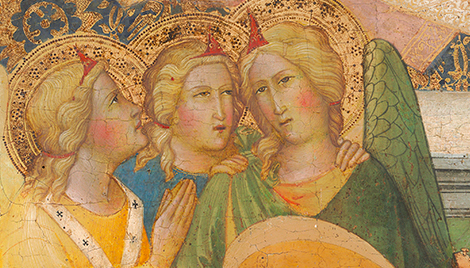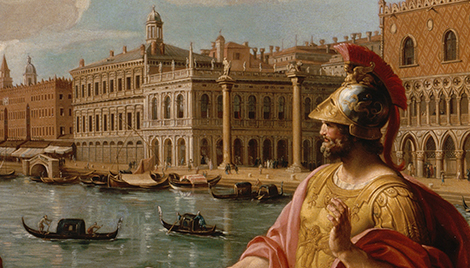Athena Scorning the Advances of Hephaestus
Athena Scorning the Advances of Hephaestus
- Artist
- Paris Bordone
- Artist Dates
- 1500-1571
- Artist Nationality
- Italian
- Title
- Athena Scorning the Advances of Hephaestus
- Date
- c. 1555-60
- Medium
- oil on canvas
- Dimensions
- 139.4 x 127.7 cm (54-7/8 x 50-1/4 in)
- K Number
- K1112
- Repository
- Museum of Art and Archaeology
- Accession Number
- 61.78
- Notes
Provenance
Edward Solly [1776-1844], London; (his sale, Christie's, London, 8 May 1847, no. 1); Anthony. Baron Frederic Leighton of Stretton [1830-1896], London; (his sale, Christie's, London, 14 July 1896, no. 349); Robert Leggatt, possibly for (Leggatt Brothers, London). Marchese Doria, Florence. (Charles Fairfax Murray [1849-1919], Florence and London). [1] (Count Alessandro Contini Bonacossi [1878-1955] Rome-Florence); sold to Samuel H. Kress [1863-1955] on 16 June 1937; gift to the National Gallery of Art in 1939; deaccessioned in 1952 and returned to the Samuel H. Kress Foundation; gift to Museum of Art and Archaeology, University of Missouri in 1961, no. 61.78. [1] Annotated photo mount in the Witt library, London.
Catalogue Entry
Paris Bordone
Athena Scorning the Advances of Hephaestus
K1112
Columbia, Mo., University of Missouri, Study Collection (61.78), since 1962. Canvas. 54 7/8 X 50 1/4 in. (139.4 X 127.7 cm.). Signed at lower left: O. PARIDIS BORDONO. Fair condition; background abraded. A typical work of Bordone's maturity,(1) K1112 was probably painted about 1555, a few years earlier than the similar composition, Jupiter and Io, now in the Goteborg Museum, which seems correctly assigned to about 1560. It would be tempting to think that the two paintings might have been pendants, but the sizes are perhaps not similar enough and the somewhat less mannered style of K1112 tends to date it earlier than the Goteborg picture. As is often the case in Bordone's mythological scenes, the subject is uncertain. Sometimes interpreted as Minerva at the Forge of Vulcan,(2) the subject of K1112 is more plausibly explained as Thetis getting from Hephaestus (Vulcan) armor for her son, Achilles.(3) With its seemingly weightless figures, floating in clouds, K1112 may have been painted as a ceiling or overdoor decoration. Provenance: Edward Solly, London (sold, Christie's, London, May 8, 1847, no. I, as Bordone; bought by Anthony). Frederick Leighton (Lord Leighton of Stretton), London – exhibited: Royal Academy, 1882, no 211, as Hephaestus and Thetis by Bordone (sold, Christie's, London, July 14, 1896, no. 349, as Bordone; bought by R. Legg). Marchese Doria, Genoa. Contini Bonacossi, Florence. Kress acquisition, 1937 -exhibited: National Gallery of Art, Washington, D.C. (474), 1941-51;(4) Honolulu Academy of Arts, Honolulu, Hawaii, 1952-60.(5)
References
(1) K1112 has been accepted as typical of Bordone by L. Bailo and G. Biscaro (Della Vita e delle opere di Paris Bordon, 1900, p. 199, where it is said to have disappeared after the Leighton sale of 1896, and where Gronau and Cook are cited as having expressed acceptance of the painting as by Bordone), G. Fiocco, R. Longhi, F. M. Perkins, A. Venturi, B. Berenson (Italian Pictures ... Venetian School, vol. I, 1957, p.47, as Venus and Vulcan), and G. Canova (Paris Bardon, 1964, pp. 59, 103). (2) See note 4, below. (3) Iliad, xviii. This interpretation of K1112 was followed at least as early as 1882 (see Provenance, above, and J. P. Richter, in Kunstchronik, vol. XVII, 1882, p. 286, discussing the subject and noting that the painting had been recently acquired in Italy). (4) Preliminary Catalogue, 1941, pp. 27 f., as Minerva at the Forge of Vulcan, by Bordone. (5) Catalogue by W. E. Suida, 1952, p.56, as Thetis and Hephaestus, by Bordone.






